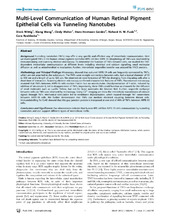| dc.description.abstract | Background: Tunneling nanotubes (TNTs) may offer a very specific and effective way of intercellular communication. Here we investigated TNTs in the human retinal pigment epithelial (RPE) cell line ARPE-19. Morphology of TNTs was examined by immunostaining and scanning electron microscopy. To determine the function of TNTs between cells, we studied the TNT-dependent intercellular communication at different levels including electrical and calcium signalling, small molecular diffusion as well as mitochondrial re-localization. Further, intercellular organelles transfer was assayed by FACS analysis. Methodology and Principal Findings: Microscopy showed that cultured ARPE-19 cells are frequently connected by TNTs, which are not attached to the substratum. The TNTs were straight connections between cells, had a typical diameter of 50 to 300 nm and a length of up to 120 µm. We observed de novo formation of TNTs by diverging from migrating cells after a short time of interaction. Scanning electron microscopy confirmed characteristic features of TNTs. Fluorescence microscopy revealed that TNTs between ARPE-19 cells contain F-actin but no microtubules. Depolymerisation of F-actin, induced by addition of latrunculin-B, led to disappearance of TNTs. Importantly, these TNTs could function as channels for the diffusion of small molecules such as Lucifer Yellow, but not for large molecules like Dextran Red. Further, organelle exchange between cells via TNTs was observed by microscopy. Using Ca2+ imaging we show the intercellular transmission of calcium signals through TNTs. Mechanical stimulation led to membrane depolarisation, which expand through TNT connections between ARPE-19 cells. We further demonstrate that TNTs can mediate electrical coupling between distant cells. Immunolabelling for Cx43 showed that this gap junction protein is interposed at one end of 44% of TNTs between ARPE-19 cells. Conclusions and Significance: Our observations indicate that human RPE cell line ARPE-19 cells communicate by tunneling nanotubes and can support different types of intercellular traffic. | en_US |

